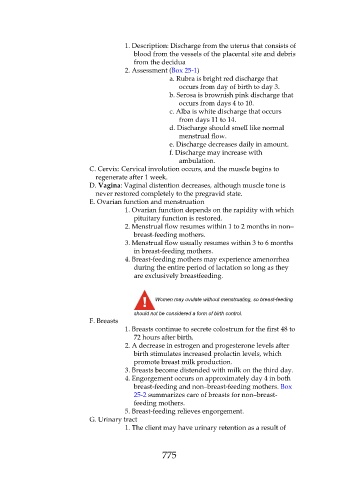Page 775 - Saunders Comprehensive Review For NCLEX-RN
P. 775
1. Description: Discharge from the uterus that consists of
blood from the vessels of the placental site and debris
from the decidua
2. Assessment (Box 25-1)
a. Rubra is bright red discharge that
occurs from day of birth to day 3.
b. Serosa is brownish pink discharge that
occurs from days 4 to 10.
c. Alba is white discharge that occurs
from days 11 to 14.
d. Discharge should smell like normal
menstrual flow.
e. Discharge decreases daily in amount.
f. Discharge may increase with
ambulation.
C. Cervix: Cervical involution occurs, and the muscle begins to
regenerate after 1 week.
D. Vagina: Vaginal distention decreases, although muscle tone is
never restored completely to the pregravid state.
E. Ovarian function and menstruation
1. Ovarian function depends on the rapidity with which
pituitary function is restored.
2. Menstrual flow resumes within 1 to 2 months in non–
breast-feeding mothers.
3. Menstrual flow usually resumes within 3 to 6 months
in breast-feeding mothers.
4. Breast-feeding mothers may experience amenorrhea
during the entire period of lactation so long as they
are exclusively breastfeeding.
Women may ovulate without menstruating, so breast-feeding
should not be considered a form of birth control.
F. Breasts
1. Breasts continue to secrete colostrum for the first 48 to
72 hours after birth.
2. A decrease in estrogen and progesterone levels after
birth stimulates increased prolactin levels, which
promote breast milk production.
3. Breasts become distended with milk on the third day.
4. Engorgement occurs on approximately day 4 in both
breast-feeding and non–breast-feeding mothers. Box
25-2 summarizes care of breasts for non–breast-
feeding mothers.
5. Breast-feeding relieves engorgement.
G. Urinary tract
1. The client may have urinary retention as a result of
775

